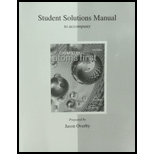
Concept explainers
Define the term compound and explain how a compound differs from a mixture.
Interpretation: Definition of compound and its difference from mixture to be discussed.
Concept Introduction: Compounds are pure substances formed by chemical combination of elements in specific ratio or proportions. Mixtures are formed by addition of two or many substances physically and are impure in nature.
Answer to Problem 5.1QP
Compounds are formed by chemical combination of elements in specific ratio which cannot be separated without chemical methods whereas a mixture is a formed by combining two or more substances in any proportion which can be separated by physical methods itself.
Explanation of Solution
Compounds are pure substances, which are formed by chemical combination of two or many elements in specific proportion and does not possess the characteristics of its individual constituents. The constituents of compound can only be separated by chemical methods.
Mixtures are impure substances, which are formed by mixing of two or many substances physically in any proportion. The characteristic of mixture will be similar to the characteristic of its individual components. Physical methods are enough to separate the constituents of mixture
Difference between Compound and Mixture
| Compounds | Mixtures |
| They are pure in nature | They are impure in nature |
| Formed in specific proportion by chemical combination | No specific proportion for mixture and are formed by physical combination |
| Differ from characteristics of individual components | Similar to the characteristics of its individual components |
| Separation of constituents by chemical methods | Separation by physical methods |
| Melting points and boiling points are fixed | Melting points and boiling points are not fixed |
| Results in the formation of new substance | No any new substance will be formed |
The definition for the term compound and its difference from mixture was explained.
Want to see more full solutions like this?
Chapter 5 Solutions
Student Solutions Manual For Chemistry: Atoms First
- Explain the termselement, afoul, and compound. Provide an example and microscopic drawing of each.arrow_forwardWhat is acompound? What are compounds composed of? What is true about the composition of a compound, no matter where we happen to find the compound?arrow_forwardContrast the two general types of chemical compounds in terms of their general physical properties.arrow_forward
- Sketch a magnified view (showing atoms/molecules) of each of the following and explain: a. a heterogeneous mixture of two different compounds b. a homogeneous mixture of an element and a compoundarrow_forwardConsider the chemical reaction as depicted below. Label as much as you can using the terms atom, molecule, element, compound, ionic, gas, and solid.arrow_forwardIs it possible for the same Iwo elements to form more than one compound? Is this consistent with Dalton’s atomic theory? Give an example.arrow_forward
 World of Chemistry, 3rd editionChemistryISBN:9781133109655Author:Steven S. Zumdahl, Susan L. Zumdahl, Donald J. DeCostePublisher:Brooks / Cole / Cengage Learning
World of Chemistry, 3rd editionChemistryISBN:9781133109655Author:Steven S. Zumdahl, Susan L. Zumdahl, Donald J. DeCostePublisher:Brooks / Cole / Cengage Learning Introductory Chemistry: A FoundationChemistryISBN:9781337399425Author:Steven S. Zumdahl, Donald J. DeCostePublisher:Cengage LearningChemistry: Matter and ChangeChemistryISBN:9780078746376Author:Dinah Zike, Laurel Dingrando, Nicholas Hainen, Cheryl WistromPublisher:Glencoe/McGraw-Hill School Pub Co
Introductory Chemistry: A FoundationChemistryISBN:9781337399425Author:Steven S. Zumdahl, Donald J. DeCostePublisher:Cengage LearningChemistry: Matter and ChangeChemistryISBN:9780078746376Author:Dinah Zike, Laurel Dingrando, Nicholas Hainen, Cheryl WistromPublisher:Glencoe/McGraw-Hill School Pub Co Living By Chemistry: First Edition TextbookChemistryISBN:9781559539418Author:Angelica StacyPublisher:MAC HIGHER
Living By Chemistry: First Edition TextbookChemistryISBN:9781559539418Author:Angelica StacyPublisher:MAC HIGHER Chemistry: Principles and PracticeChemistryISBN:9780534420123Author:Daniel L. Reger, Scott R. Goode, David W. Ball, Edward MercerPublisher:Cengage Learning
Chemistry: Principles and PracticeChemistryISBN:9780534420123Author:Daniel L. Reger, Scott R. Goode, David W. Ball, Edward MercerPublisher:Cengage Learning General, Organic, and Biological ChemistryChemistryISBN:9781285853918Author:H. Stephen StokerPublisher:Cengage Learning
General, Organic, and Biological ChemistryChemistryISBN:9781285853918Author:H. Stephen StokerPublisher:Cengage Learning





